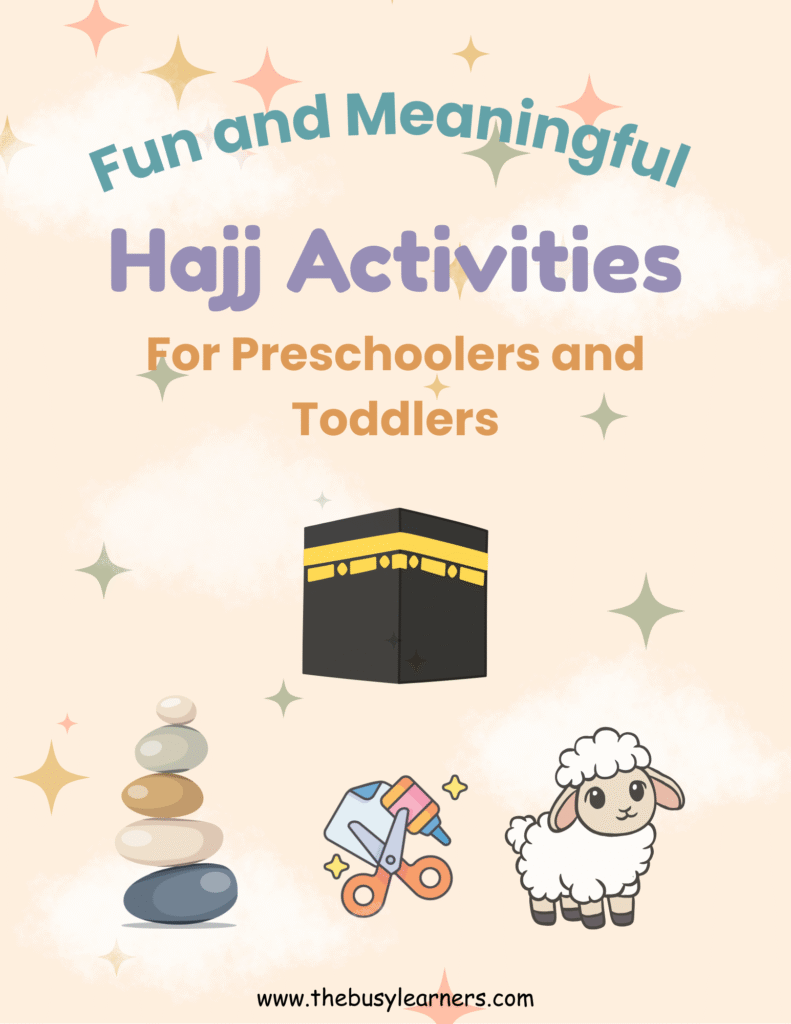
Looking for fun and meaningful Hajj activities for toddlers and preschoolers? Teaching young children about Hajj can be an enriching experience, especially when you use hands-on Islamic crafts and play-based learning. Whether you’re a homeschooler or a parent wanting to bring the spirit of Hajj into your home, these engaging activities will help little ones connect with this special journey in Islam. From Ka’bah craft boxes to Zamzam water play, these step-by-step ideas are perfect for early learners to explore the pillars of Hajj in a joyful way.
Thank you for reading this post, don't forget to subscribe!1. DIY Ka'bah Craft Box
Objective: Introduce the Ka’bah as the holiest site in Islam.
Materials: Small cardboard box, black paint or paper, gold/yellow foil or paper, glue/tape
Instructions:
Wrap or paint the box black.
Cut out a small rectangle from gold paper to represent the door.
Attach a gold strip near the top to mimic the kiswah design.
Allow your child to decorate it and explore its shape.
Impact: This craft helps children recognize the Ka’bah as a central symbol in Hajj and develops fine motor skills, creativity, and cultural awareness.
2. Hajj Footsteps Trail
Objective: Teach the main steps of Hajj in a playful and physical way.
Materials: Printable footsteps, step labels (Ka’bah, Mina, Arafah, Muzdalifah, Jamarat, Eid), tape
Instructions:
Place footsteps around a room or yard in a path.
Label each set with a Hajj location.
Walk through the path with your child, narrating each step.
Impact: This activity boosts gross motor skills and memory through movement-based learning while reinforcing the sequence of Hajj.
3. Zamzam Water Play Station
Objective: Introduce the story of Hajar (AS) and the miraculous Zamzam water.
Materials: Water tub, cups/spoons, blue pebbles (optional)
Instructions:
- Set up a small water station.
- Talk about Hajar running between Safa and Marwa.
- Let the child pour, scoop, and play.
Impact: Water play is calming and sensory-rich. While playing, children connect with Hajar’s perseverance, building emotional and spiritual understanding.
4. Pebble Painting for Jamarat
Objective: Teach the concept of resisting bad behavior using the stoning ritual of the Jamarat.
Materials: 7 small stones, paint, pouch or paper cup
Instructions:
Let your child paint or decorate each pebble.
Use a simple cardboard pillar to mimic the Jamarat.
Gently toss the pebbles while saying things like “go away bad choices!”
Impact: Encourages emotional learning and teaches children to recognize and reject negative actions in a developmentally appropriate way.
5. Eid al-Adha Sheep Craft
Objective: Introduce the story of Prophet Ibrahim (AS) and the significance of sacrifice.
Materials: Paper plate, cotton balls, googly eyes, glue, black paper
Instructions:
Glue cotton balls onto the paper plate.
Add eyes, ears, and legs to make a sheep.
Discuss the Eid story in simple words.
Impact: Supports storytelling, creativity, and understanding of Eid al-Adha, while building fine motor skills.
6. Hajj Steps Story Mat Activity
Objective: Teach the sequence of Hajj through a hands-on, storytelling approach.
Materials: Cardboard or large paper, markers, Hajj location pictures, toy figure
Instructions:
Divide the board into labeled sections: Makkah, Mina, Arafah, Muzdalifah, Jamarat, Eid.
Draw or paste each location.
Use a small toy figure to travel from one place to another as you tell the story.
Impact: Combines imaginative play with faith-based learning, reinforcing story sequencing, language development, and spiritual connection.
These Hajj-themed crafts and activities are not only fun, but they also plant seeds of love for Islam in young hearts. Each activity introduces core concepts of Hajj while supporting early childhood development—from motor skills to emotional regulation. Whether you’re teaching in a homeschool setting or creating memories at home during Dhul Hijjah, these ideas are a wonderful way to bring faith to life for your toddlers and preschoolers.
If you found these ideas helpful, be sure to explore our other Islamic activity guides for kids at The Busy Learners. Don’t forget to share your little learner’s creations with us online!
